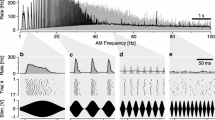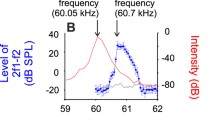Summary
The cochlea of the mustache bat, Pteronotus parnellii, is very sensitive and sharply tuned to the frequency range of the dominant second harmonic of the echolocation call around 61 kHz. About 900 Hz above this frequency the cochlear microphonic potential (CM) reaches its maximum amplitude and lowest threshold. At exactly the same frequency, pronounced evoked otoacoustic emissions (OAE) can be measured in the outer ear canal, indicating mechanical resonance. The CM amplitude maximum and the OAE are most severely masked by simultaneous exposure to tones within the range from about 61–62 kHz up to about 70 kHz. The data suggest that the mechanism of mechanical resonance involves cochlear loci basal to the 61 kHz position.
The resonance contributes to auditory sensitivity and sharp tuning: At the frequency of the OAE, single unit responses in the cochlear nucleus have the lowest thresholds. Maximum tuning sharpness occurs at frequencies about 300 Hz below the OAE-frequency, where the threshold is about 10 dB less sensitive than at the OAE-frequency. In addition, in the frequency range around the OAE-frequency several specialized neuronal response features can be related to mechanical resonance: Long lasting excitation after the end of the stimulus, asymmetrical tuning curves with a shallow high frequency slope and phasic ‘on-off’ neuronal response patterns. In particular the latter phenomenon indicates the occurrence of local mechanical cancellations in the cochlea.
Similar content being viewed by others
Abbreviations
- CF :
-
constant frequency component of echolocation calls
- CM :
-
cochlear microphonic potential
- FM :
-
frequency modulated component of echolocation calls
- N1 :
-
compound action potential of the auditory nerve
- OAE :
-
octoacoustic emission
- SEOAE :
-
synchronous evoked OAE
References
Bodenhamer RD, Pollak GD (1983) Response characteristics of single units in the inferior colliculus of mustache bats to sinusoidally frequency modulated signals. J Comp Physiol 153:67–79
Dallos P (1981) Cochlear physiology. Annu Rev Psychol 32:153–190
Davis H (1965) A model for transducer action in the cochlea. Cold Spring Harbor Symp Quant Biol 30:181–189
Duifhuis H, Vater M (1985) On the mechanics of the horseshoe bat cochlea. In: Allen JB, Hall JL, Hubbard A, Neely ST, Tubis A (eds): Peripheral auditory mechanisms. Springer, Berlin Heidelberg New York, pp 89–96
Evans EF, Nelson PG (1973a) The responses of single neurons in the cochlear nucleus of the cat as a function of their location and anaesthetic state. Exp Brain Res 17:402–427
Evans EF, Nelson PG (1973b) On the functional relationship between the dorsal and ventral divisions of the cochlear nucleus of the cat. Exp Brain Res 17:428–442
Feng AS, Vater M (1985) Functional organization of the cochlear nucleus of rufous horseshoe bats (Rhinolophus rouxi): Frequencies and internal connections are arranged in slabs. J Comp Neurol 235:529–555
Grinnell AD (1970) Comparative auditory neurophysiology of neotropical bats employing different echolocation signals. Z Vergl Physiol 68:117–153
Henson MM, Henson OW Jr, Goldman LJ (1977) The perilymphatic spaces in the cochlea of the bat, Pteronotus p. parnellii (Gray). Anat Rec 87:767
Henson OW Jr, Henson MM (1989) Morphometric analysis of cochlear structures in the mustached bat, Pteronotus parnellii parnellii. In: Nachtigall PE (ed) Animal sonar systems: processes and performance. Plenum Press, New York 156: 301–305
Henson OW Jr, Pollak GD (1972) A technique for chronic implantation of electrodes in the cochleae of bats. Physiol Behav 8:1185–1188
Henson OW Jr, Pollak GD, Kobler JB, Henson MM, Goldman LJ (1982) Cochlear microphonic potentials elicited by bisonar signals in flying bats, Pteronotus p. parnellii. Hearing Res 7:127–147
Henson OW Jr, Keating AW, Fitzpatrick DC, Huffman RF (1988) Cochlear resonance in the mustached bat, Pteronotus p. parnellii. In: Lim DJ (ed) Abstracts of the 11th Midwinter Research Meeting, Assoc. for Research in Otolaryngology, p 17–18
Henson OW Jr, Schuller G, Vater M (1985) A comparative study on the physiological properties of the inner ear in Doppler shift compensating bats (Rhinolophus rouxi and Pteronotus parnellii). J Comp Physiol A 157:587–597
Kemp DT (1979) The evoked cochlear mechanical response and the auditory microstructure — evidence for a new element in cochlear mechanics. Scand Audiol Suppl 9:35–47
Kössl M, Vater M (1985a) Evoked acoustic emissions and cochlear microphonics in the mustache bat, Pteronotus parnellii. Hearing Res 19:157–170
Kössl M, Vater M (1985b) The cochlear frequency map of the mustache bat, Pteronotus parnellii. J Comp Physiol A 157:687–697
Kössl M, Vater M (1990) Tonotopic organization of the cochlear nucleus of the mustache bat, Pteronotus parnellii. J Comp Physiol A 166:695–709
Metzner W, Radtke-Schuller S (1987) The nuclei of the lateral lemniscus in the rufous horseshoe bat, Rhinolophus rouxi. J Comp Physiol A 160:395–411
Pollak G, Henson OW Jr, Novick A (1972) Cochlear microphonic audiograms in the ‘pure tone’ bat Chilonycteris parnellii parnellii. Science 176:66–68
Pollak GD, Henson OW Jr, Johnson R (1979) Multiple specializations in the peripheral auditory system of the CF-FM bat, Pteronotus parnellii. J Comp Physiol 131:255–266
Russell IJ (1983) Origin of the receptor potential in inner hair cells of the mammalian cochlea — evidence for Davis' theory. Nature 301:334–336
Saunders JC, Dear SP, Schneider ME (1985) The anatomical consequences of acoustic injury: A review and tutorial. J Acoust Soc Am 78:833–860
Suga N (1984) Neural mechanisms of complex-sound processing for echolocation. Trends Neurosci 7:20–27
Suga N, Jen PH-S (1977) Further studies on the peripheral auditory system of ‘CF-FM’ bats specialized for fine frequency analysis of Doppler-shifted echoes. J Exp Biol 69:207–232
Suga N, Simmons JA, Jen PH-S (1975) Peripheral specialization for fine frequency analysis of Doppler-shifted echoes in the auditory system of the ‘CF-FM’ bat Pteronotus parnellii. J Exp Biol 63:161–192
Suga N, O'Neill WE, Manabe T (1978) Cortical neurons sensitive to combinations of information-bearing elements of bisonar signals in the mustache bat. Science 200:778–781
Suga N, O'Neill WE, Manabe T (1979) Harmonic-sensitive neurons in the auditory cortex of the mustache bat. Science 203:270–273
Suga N, Tsuzuki K (1985) Inhibition and level-tolerant frequency tuning in the auditory cortex of the mustached bat. J Neurophysiol 53:1109–1145
Thomas IB (1975) Microstructure of pure tone threshold. J Acoust Soc Am 57:26–27
Vater M, Feng AS, Betz M (1985) An HRP-study of the frequency-place map of the horseshoe bat cochlea: Morphological correlates of the sharp tuning to a narrow frequency band. J Comp Physiol A 157:671–686
Zwicker E, Schloth E (1984) Interrelation of different oto-acoustic emissions. J Acoust Soc Am 75:1148–1154
Author information
Authors and Affiliations
Rights and permissions
About this article
Cite this article
Kössl, M., Vater, M. Resonance phenomena in the cochlea of the mustache bat and their contribution to neuronal response characteristics in the cochlear nucleus. J Comp Physiol A 166, 711–720 (1990). https://doi.org/10.1007/BF00240020
Accepted:
Issue Date:
DOI: https://doi.org/10.1007/BF00240020




